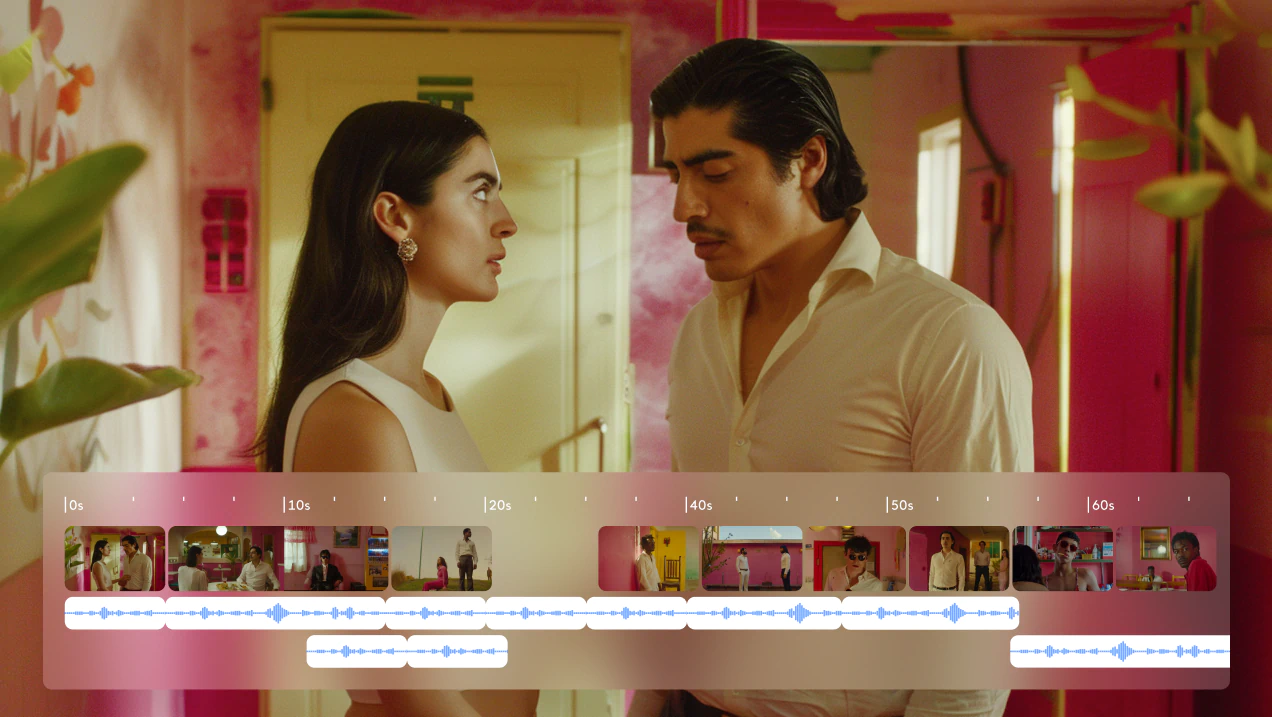The real movie magic doesn’t happen on set—it happens in the edit where raw footage becomes a complete film. From cutting together disparate shots into a coherent narrative to adding the final colour grade that defines a film’s mood, post-production is the crucial bridge between filming and finished product.
What makes post-production essential to filmmaking and how can modern platforms like LTX Studio simplify these complex workflows? Let’s explore the final filmmaking stage where technical expertise meets creative vision to craft a polished story.
{{blog-banner-video02}}
What is Post-Production?
Post-production is where all captured footage is edited, enhanced and prepared for distribution through multiple technical and creative processes. This post production process is where raw material becomes a complete film through editing, color grading, sound design and visual effects.
Think of movie post production as the bridge between filming and the finished movie, where hours of footage condense into a coherent narrative, audio elements balance for maximum emotional impact and visual consistency emerges through color correction. Cinematic post production turns disconnected shots into seamless storytelling that guides the audience’s attention and emotional engagement.
The Post-Production Process
Post-production varies depending on the type of project (live-action, animation or stop-motion) but typically involves:
Ingest & Organize Footage - transferring raw media from set and organizing clips by scene, take and technical quality to create an editable workflow.
Edit - the creative core where you cut and sequence shots for narrative flow, pacing and emotional rhythm that serves the story. Having a shot list during production ensures you’ve got all the coverage you need for the edit.
Sound Design & Mix - balancing dialogue clarity, sound effects and music for emotional impact that complements the visual story without overwhelming it.
Color Grade - adjusting tones, contrast and color relationships for visual continuity and mood. Decisions made here build on the color theory principles established during pre-production planning.
VFX - adding CGI elements, compositing layers or animation overlays that create impossible imagery or enhance practical footage. From subtle compositing to full CGI characters, VFX is part of modern filmmaking at all budget levels.
Titles, Graphics & Credits - final branding, text and presentation polish that frames the viewing experience.
Export & Master - final versions for cinema, streaming or physical distribution.
Color Correction & Grading adjusts tones, contrast and color relationships for continuity and mood. Decisions made here build on the color theory from pre-production planning.
Visual Effects (VFX) adds CGI elements, compositing layers or animation overlays that create impossible imagery or enhance practical footage. From subtle compositing to full CGI characters, VFX is part of modern filmmaking at all budget levels.
Titles, Graphics & Credits final branding, text and presentation polish that frames the viewing experience.
Exporting & Mastering final versions for cinema, streaming or physical distribution.
Each of these post production steps turns production material into polished stories. Understanding the post production process ensures realistic planning and resource allocation.
Post-Production for Different Types of Projects
Live-Action Post-Production
Post production for live-action projects focuses on editing rhythm, sound design and color grading. Film post production is critical as dialogue cleanup, ADR (Automated Dialogue Replacement), Foley recording and final mixing brings realistic audio environments that immerse the audience in story worlds.
Animation & Post-Production
For animation and post production the process starts earlier and often blends rendering, compositing and timing adjustments throughout production rather than afterwards. Animation post production includes voice acting recording, sound effects synchronization and final scene rendering that brings stylised visuals to life through technical processing.
Short Film & Stop-Motion Post-Production
Short film post production follows the same workflow as features but with faster turnaround and resource allocation, focusing on story pacing and colour mood within tighter budgets. Stop motion post production involves frame cleaning, motion synchronization and shot compositing with music or narration that enhances handcrafted visuals.
How Much Does Post-Production Cost?
Post production cost varies greatly depending on project type, complexity and professional expertise required:
Short films $500–$5,000 for basic editing, sound design and color correction for festival or online distribution.
Feature films $30,000–$250,000+ for VFX, color grading and sound mixing for theatrical or streaming release.
Animation projects often cost more due to rendering computational demands and compositing technical requirements that extend processing time and resource needs.
With AI tools like LTX Studio, you can edit, time and tone directly in one interface—less time and cost than traditional workflows that require multiple software packages and technical specialists.
Post-Production in LTX Studio
LTX Studio reimagines the post production process with AI-powered tools that combine advanced editing and cinematic capabilities in one workspace. The platform makes cinematic post production more accessible by handling the technical complexity for you while keeping creative control.
In the Storyboard or Rough Cut view, you can adjust scene flow, pacing and continuity without traditional editing software that requires technical expertise. The platform can turn storyboards into animatics bridges the gap between static planning and motion preview during the edit.

Sound allows you to add, sync or rework audio with AI voice generation or imported soundtracks that match your visuals.
Color and Lighting adjusts tone or atmosphere with text prompts in Gen Space or directly in the storyboard interfaces, no color grading software learning curve.
Visual Edits refines framing, applies transitions or export scenes for feedback that streamlines the revision process.
When your project is complete, click Share → Pitch Deck to export your finished story presentation or cinematic reel for distribution or funding pitches.
This LTX Studio post production workflow makes professional finishing faster, more visual and more accessible for filmmakers, animators and content creators regardless of technical background or software expertise.
Conclusion
Post-production is where the magic happens, where raw footage becomes a cohesive cinematic story that engages the audience emotionally and intellectually. From sound design that creates an audio environment to color grading that sets the mood and visual continuity, every movie post production step defines the emotional and visual impact of the finished film.
{{blog-banner-video04}}
Knowing the entire film post production process allows for realistic planning, budgeting and quality expectations that match your project goals. Whether you’re working on short film post production with limited resources or animation post production that requires extensive rendering, knowing the workflow stages ensures efficiency.With LTX Studio you can edit, sound and refine with AI precision and make movie post production faster than ever. The platform makes professional finishing that was previously only available with expensive software, training and time investment accessible to all.
Heading
November 13, 2025


















.png)





